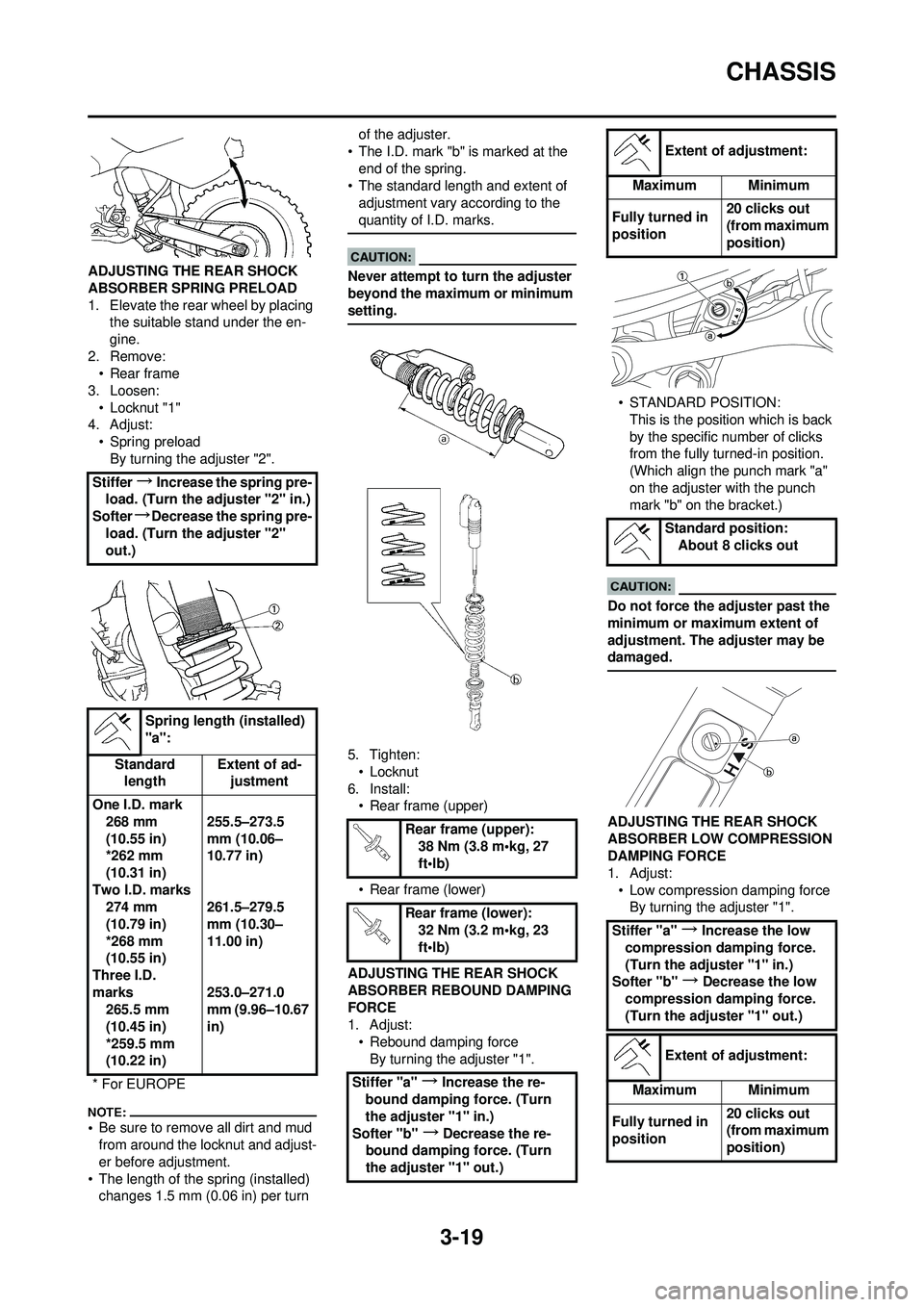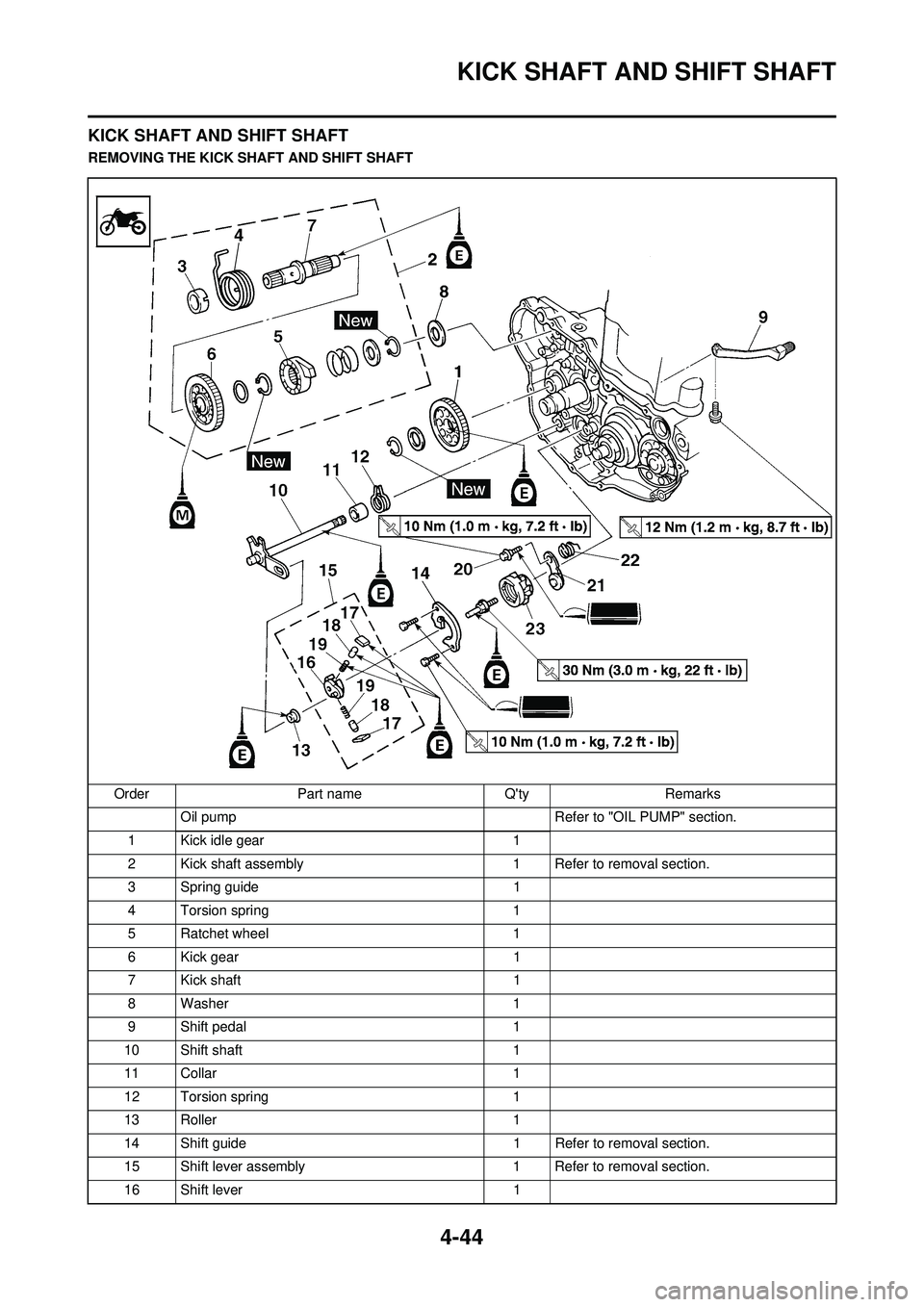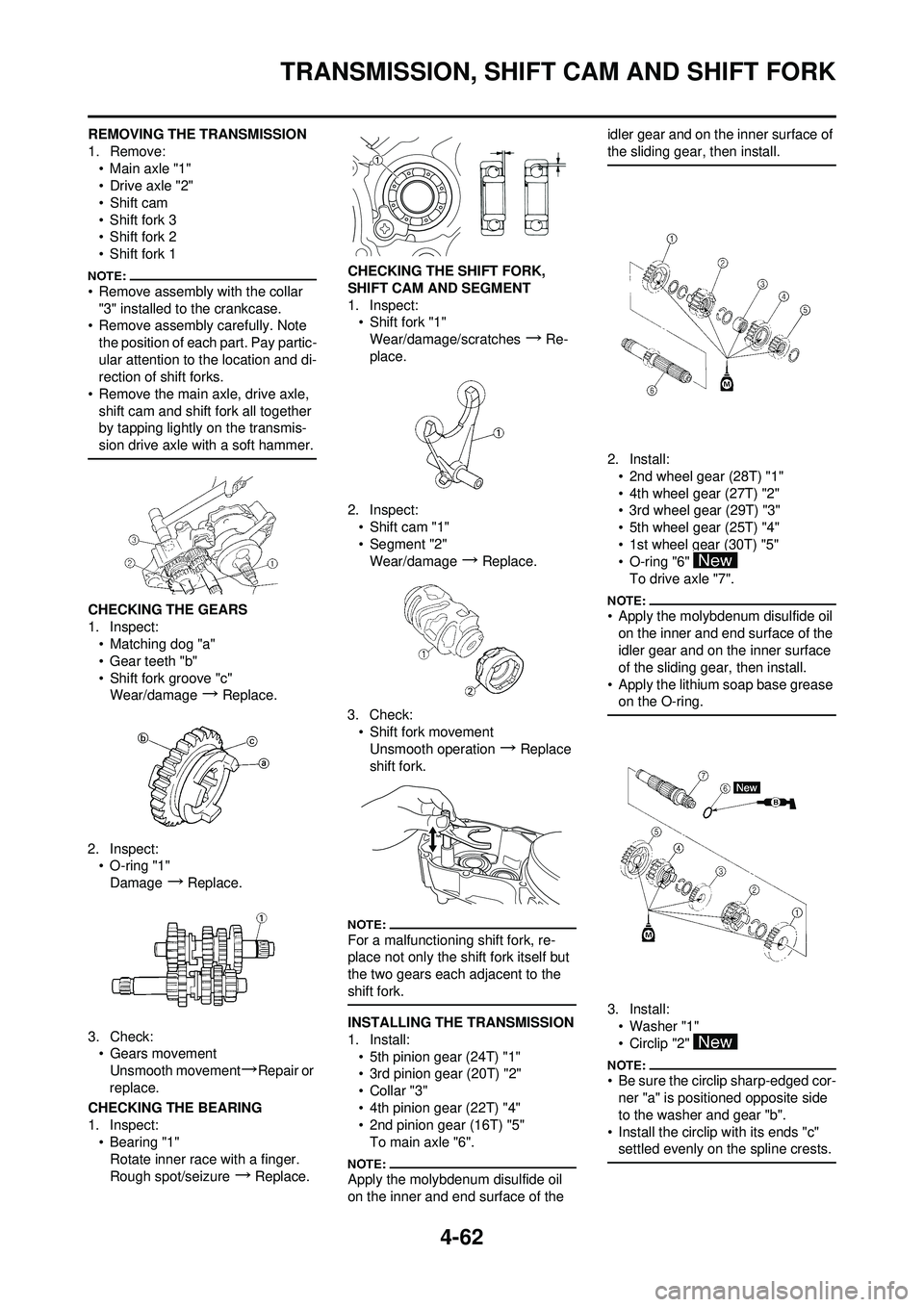2008 YAMAHA YZ250F wheel
[x] Cancel search: wheelPage 65 of 192

3-19
CHASSIS
ADJUSTING THE REAR SHOCK
ABSORBER SPRING PRELOAD
1. Elevate the rear wheel by placing the suitable stand under the en-
gine.
2. Remove: • Rear frame
3. Loosen: • Locknut "1"
4. Adjust:
• Spring preloadBy turning the adjuster "2".
•Be sure to remove all dirt and mud
from around the locknut and adjust-
er before adjustment.
• The length of the spring (installed) changes 1.5 mm (0.06 in) per turn of the adjuster.
• The I.D. mark "b" is marked at the end of the spring.
• The standard length and extent of
adjustment vary according to the
quantity of I.D. marks.
Never attempt to turn the adjuster
beyond the maximum or minimum
setting.
5. Tighten:• Locknut
6. Install: • Rear frame (upper)
• Rear frame (lower)
ADJUSTING THE REAR SHOCK
ABSORBER REBOUND DAMPING
FORCE
1. Adjust: • Rebound damping forceBy turning the adjuster "1". • STANDARD POSITION:
This is the position which is back
by the specific number of clicks
from the fully turned-in position.
(Which align the punch mark "a"
on the adjuster with the punch
mark "b" on the bracket.)
Do not force the adjuster past the
minimum or maximum extent of
adjustment. The adjuster may be
damaged.
ADJUSTING THE REAR SHOCK
ABSORBER LOW COMPRESSION
DAMPING FORCE
1. Adjust:• Low compression damping forceBy turning the adjuster "1".
Stiffer
→Increase the spring pre-
load. (Turn the adjuster "2" in.)
Softer
→Decrease the spring pre-
load. (Turn the adjuster "2"
out.)
Spring length (installed)
"a":
Standard length Extent of ad-
justment
One I.D. mark 268 mm
(10.55 in)
*262 mm
(10.31 in)
Two I.D. marks 274 mm
(10.79 in)
*268 mm
(10.55 in)
Three I.D.
marks 265.5 mm
(10.45 in)
*259.5 mm
(10.22 in) 255.5–273.5
mm (10.06–
10.77 in)
261.5–279.5
mm (10.30–
11.00 in)
253.0–271.0
mm (9.96–10.67
in)
* For EUROPE
Rear frame (upper): 38 Nm (3.8 m•kg, 27
ft•lb)
Rear frame (lower): 32 Nm (3.2 m•kg, 23
ft•lb)
Stiffer "a"
→Increase the re-
bound damping force. (Turn
the adjuster "1" in.)
Softer "b"
→Decrease the re-
bound damping force. (Turn
the adjuster "1" out.)
Extent of adjustment:
Maximum Minimum
Fully turned in
position 20 clicks out
(from maximum
position)
Standard position: About 8 clicks out
Stiffer "a"
→Increase the low
compression damping force.
(Turn the adjuster "1" in.)
Softer "b"
→Decrease the low
compression damping force.
(Turn the adjuster "1" out.)
Extent of adjustment:
Maximum Minimum
Fully turned in
position 20 clicks out
(from maximum
position)
Page 66 of 192

3-20
CHASSIS
• STANDARD POSITION:This is the position which is back
by the specific number of clicks
from the fully turned-in position.
(Which align the punch mark "a"
on the adjuster with the punch
mark "b" on the high compression
damping adjuster.)
Do not force the adjuster past the
minimum or maximum extent of
adjustment. The adjuster may be
damaged.
ADJUSTING THE REAR SHOCK
ABSORBER HIGH COMPRESSION
DAMPING FORCE
1. Adjust:• High compression damping force
By turning the adjuster "1".
• STANDARD POSITION: This is the position which is back
by the specific number of turns
from the fully turned-in position.
(Which align the punch mark "a"
on the adjuster with the punch
mark "b" on the adjuster body.)
Do not force the adjuster past the
minimum or maximum extent of
adjustment. The adjuster may be
damaged.
CHECKING THE TIRE PRESSURE
1. Measure:
• Tire pressureOut of specification
→Adjust.
•Check the tire while it is cold.
• Loose bead stoppers allow the tire
to slip off its position on the rim
when the tire pressure is low.
• A tilted tire valve stem indicates that
the tire slips off its position on the
rim.
• If the tire valve stem is found tilted,
the tire is considered to be slipping
off its position. Correct the tire posi-
tion.
CHECKING AND TIGHTENING THE
SPOKES
1. Inspect:• Spokes "1"Bend/damage
→Replace.
Loose spoke
→Retighten.
2. Tighten: •Spokes
Be sure to retighten these spokes be-
fore and after break-in. After a prac-
tice or a race check spokes for
looseness.
CHECKING THE WHEELS
1. Inspect:
• Wheel runoutElevate the wheel and turn it.
Abnormal runout
→ Replace.
2. Inspect: • Bearing free play
Exist play
→Replace.
CHECKING AND ADJUSTING THE
STEERING HEAD
1. Elevate the front wheel by placing a suitable stand under the engine.
2. Check:
• Steering stemGrasp the bottom of the forks and
gently rock the fork assembly
back and forth.
Free play
→Adjust steering head.
Standard position:
About 8 clicks out
Stiffer "a"
→Increase the high
compression damping force.
(Turn the adjuster "1" in.)
Softer "b"
→Decrease the high
compression damping force.
(Turn the adjuster "1" out.)
Extent of adjustment:
Maximum Minimum
Fully turned in
position 2 turns out
(from maximum
position)
Standard position:
About 1-1/2 turns out
Standard tire pressure: 100 kPa (1.0 kgf/cm
2,
15 psi)
Spokes: 3 Nm (0.3 m•kg, 2.2
ft•lb)
Page 113 of 192

4-44
KICK SHAFT AND SHIFT SHAFT
KICK SHAFT AND SHIFT SHAFT
REMOVING THE KICK SHAFT AND SHIFT SHAFTOrder Part name Q'ty Remarks Oil pump Refer to "OIL PUMP" section.
1 Kick idle gear 1
2 Kick shaft assembly 1 Refer to removal section.
3 Spring guide 1
4 Torsion spring 1
5 Ratchet wheel 1
6 Kick gear 1
7 Kick shaft 1
8 Washer 1
9 Shift pedal 1
10 Shift shaft 1
11 Collar 1
12 Torsion spring 1
13 Roller 1
14 Shift guide 1 Refer to removal section.
15 Shift lever assembly 1 Refer to removal section.
16 Shift lever 1
Page 115 of 192

4-46
KICK SHAFT AND SHIFT SHAFT
REMOVING THE KICK SHAFT
ASSEMBLY
1. Remove:• Kick shaft assembly "1"
Unhook the torsion spring "2" from
the hole "a" in the crankcase.
REMOVING THE SHIFT GUIDE
AND SHIFT LEVER ASSEMBLY
1. Remove:
• Bolt (shift guide)
• Shift guide "1"
• Shift lever assembly "2"
The shift lever assembly is disassem-
bled at the same time as the shift
guide.
REMOVING THE SEGMENT
1. Remove:• Bolt (segment) "1"
• Segment "2"
Turn the segment counterclockwise
until it stops and loosen the bolt.
If the segment gets an impact, it
may be damaged. Take care not to
give an impact to the segment
when removing the bolt.
CHECKING THE KICK SHAFT AND
RATCHET WHEEL
1. Check:• Ratchet wheel "1" smooth move-ment
Unsmooth movement
→Replace. • Kick shaft "2"
Wear/damage
→Replace.
• Spring "3" Broken
→Replace.
CHECKING THE KICK GEAR, KICK
IDLE GEAR AND RATCHET
WHEEL
1. Inspect: • Kick gear "1"
• Kick idle gear "2"
• Ratchet wheel "3"
• Gear teeth "a"
• Ratchet teeth "b"Wear/damage
→Replace.
CHECKING THE SHIFT SHAFT
1. Inspect: • Shift shaft "1"Bend/damage
→Replace.
• Spring "2"
Broken
→Replace.
CHECKING THE SHIFT GUIDE AND
SHIFT LEVER ASSEMBLY
1. Inspect: • Shift guide "1"
• Shift lever "2"
•Pawl "3"
• Pawl pin "4"
• Spring "5"
Wear/damage
→Replace.
CHECKING THE STOPPER LEVER
1. Inspect: • Stopper lever "1"
Wear/damage
→Replace.
• Torsion spring "2" Broken
→Replace.
INSTALLING THE SEGMENT
1. Install: • Segment "1"
• Bolt (segment)
Align the notch "a" on the segment
with the pin "b" on the shift cam.
If the segment gets an impact, it
may be damaged. Take care not to
give an impact to the segment
when tightening the bolt.
INSTALLING THE STOPPER
LEVER
1. Install:
• Torsion spring "1"
• Stopper lever "2"
• Bolt (stopper lever) "3"
Align the stopper lever roller with the
slot on segment.
Bolt (segment): 30 Nm (3.0 m•kg, 22
ft•lb)
Bolt (stopper lever): 10 Nm (1.0 m•kg, 7.2
ft•lb)
Page 116 of 192

4-47
KICK SHAFT AND SHIFT SHAFT
INSTALLING THE SHIFT GUIDE
AND SHIFT LEVER ASSEMBLY
1. Install:• Spring "1"
• Pawl pin "2"
•Pawl "3"To shift lever "4".
Apply the engine oil on the spring,
pawl pin and pawl.
2. Install:• Shift lever assembly "1"
To shift guide "2".
3. Install: • Shift lever assembly "1"
• Shift guide "2"
• The shift lever assembly is installed
at the same time as the shift guide.
• Apply the engine oil on the bolt
(segment) shaft.
4. Install:• Bolt (shift guide) "1" INSTALLING THE SHIFT SHAFT
1. Install:
•Roller "1"
•Collar "2"
• Torsion spring "3"
• Shift shaft "4"
Apply the engine oil on the roller and
shift shaft.
2. Install:• Shift pedal "1"
• Bolt (shift pedal) "2"
When installing the shift pedal onto
the shift shaft, be sure that the center
of the shift pedal is about 0 mm (0 in)
"a" above the top of the footrest.
INSTALLING THE KICK SHAFT
ASSEMBLY
1. Install:• Kick gear "1"
•Washer "2"
•Circlip "3"
• Ratchet wheel "4"
• Spring "5"
•Washer "6"
•Circlip "7" To kick shaft "8".
• Apply the molybdenum disulfide oil
on the inner circumferences of the
kick gear and ratchet wheel.
• Align the punch mark "a" on the
ratchet wheel with the punch mark
"b" on the kick shaft.
2. Install:• Torsion spring "1"To kick shaft "2".
Make sure the stopper "a" of the tor-
sion spring fits into the hole "b" on the
kick shaft.
3. Install:• Spring guide "1"
Slide the spring guide into the kick
shaft, make sure the groove "a" in the
spring guide fits on the stopper of the
torsion spring.
4. Install:
• Kick shaft assembly "1"
• Washer "2"
• Apply the molybdenum disulfide grease on the contacting surfaces
of the kick shaft stopper "a" and kick
shaft ratchet wheel guide "3".
• Apply the engine oil on the kick shaft.
• Slide the kick shaft assembly into
the crankcase and make sure the
kick shaft stopper "a" fits into the
kick shaft ratchet wheel guide.
Bolt (shift guide): 10 Nm (1.0 m•kg, 7.2
ft•lb)
Bolt (shift pedal):12 Nm (1.2 m•kg, 8.7
ft•lb)
Page 119 of 192

4-50
CDI MAGNETO
REMOVING THE ROTOR
1. Remove:• Nut (rotor) "1"
• Washer "2"Use the rotor holding tool "3".
2. Remove: • Rotor "1"Use the flywheel puller "2".
When installing the flywheel puller,
turn it counterclockwise.
CHECKING THE CDI MAGNETO
1. Inspect:• Rotor inner surface "a"
• Stator outer surface "b"
Damage
→Inspect the crankshaft
runout and crankshaft bearing.
If necessary, replace CDI magne-
to and/or stator.
CHECKING THE WOODRUFF KEY
1. Inspect: • Woodruff key "1"Damage
→Replace. INSTALLING THE CDI MAGNETO
1. Install:
•Stator "1"
• Screw (stator) "2"
• Apply the sealant on the grommet of the CDI magneto lead.
• Tighten the screws using the T30 bit.
2. Install:
• Woodruff key "1"
•Rotor "2"
• Clean the tapered portions of the crankshaft and rotor.
• When installing the woodruff key, make sure that its flat surface "a" is
in parallel with the crankshaft center
line "b".
• When installing the rotor, align the keyway "c" of the rotor with the
woodruff key.
3. Install:•Washer "1"
• Nut (rotor) "2"
Use the rotor holding tool "3". 4. Connect:
• CDI magneto leadRefer to "CABLE ROUTING DIA-
GRAM" section in the CHAPTER
2.
5. Install: • Dowel pin
• Gasket (left crankcase cover)
• Left crankcase cover "1"
• Hose guide (cylinder head breath-er hose) "2"
• Bolt (left crankcase cover)
Tighten the bolts in stage, using a
crisscross pattern.
Rotor holding tool:
YU-1235/90890-01235
Flywheel puller: YM-1189/90890-01189
Screw (stator):
10 Nm (1.0 m•kg,
7.2ft•lb)
YAMAHA Bond No. 1215
(ThreeBond
® No. 1215):
90890-85505
Nut (rotor): 56 Nm (5.6 m•kg, 40
ft•lb)
Rotor holding tool: YU-1235/90890-01235
Bolt (left crankcase cov-
er):10 Nm (1.0 m•kg, 7.2
ft•lb)
Page 131 of 192

4-62
TRANSMISSION, SHIFT CAM AND SHIFT FORK
REMOVING THE TRANSMISSION
1. Remove:• Main axle "1"
•Drive axle "2"
•Shift cam
• Shift fork 3
• Shift fork 2
• Shift fork 1
• Remove assembly with the collar "3" installed to the crankcase.
• Remove assembly carefully. Note
the position of each part. Pay partic-
ular attention to the location and di-
rection of shift forks.
• Remove the main axle, drive axle, shift cam and shift fork all together
by tapping lightly on the transmis-
sion drive axle with a soft hammer.
CHECKING THE GEARS
1. Inspect:• Matching dog "a"
• Gear teeth "b"
• Shift fork groove "c"Wear/damage
→Replace.
2. Inspect: • O-ring "1"
Damage
→Replace.
3. Check: • Gears movement
Unsmooth movement
→Repair or
replace.
CHECKING THE BEARING
1. Inspect: • Bearing "1"
Rotate inner race with a finger.
Rough spot/seizure
→Replace. CHECKING THE SHIFT FORK,
SHIFT CAM AND SEGMENT
1. Inspect:
• Shift fork "1"
Wear/damage/scratches
→Re-
place.
2. Inspect: • Shift cam "1"
• Segment "2"Wear/damage
→Replace.
3. Check: • Shift fork movement
Unsmooth operation
→Replace
shift fork.
For a malfunctioning shift fork, re-
place not only the shift fork itself but
the two gears each adjacent to the
shift fork.
INSTALLING THE TRANSMISSION
1. Install: • 5th pinion gear (24T) "1"
• 3rd pinion gear (20T) "2"
•Collar "3"
• 4th pinion gear (22T) "4"
• 2nd pinion gear (16T) "5"To main axle "6".
Apply the molybdenum disulfide oil
on the inner and end surface of the idler gear and on the inner surface of
the sliding gear, then install.
2. Install:
• 2nd wheel gear (28T) "1"
• 4th wheel gear (27T) "2"
• 3rd wheel gear (29T) "3"
• 5th wheel gear (25T) "4"
• 1st wheel gear (30T) "5"
• O-ring "6" To drive axle "7".
• Apply the molybdenum disulfide oil on the inner and end surface of the
idler gear and on the inner surface
of the sliding gear, then install.
• Apply the lithium soap base grease on the O-ring.
3. Install:
• Washer "1"
• Circlip "2"
• Be sure the circlip sharp-edged cor-ner "a" is positioned opposite side
to the washer and gear "b".
• Install the circlip with its ends "c" settled evenly on the spline crests.
Page 132 of 192

4-63
TRANSMISSION, SHIFT CAM AND SHIFT FORK
4. Install:•Collar "1"
• Apply the lithium soap base grease on the oil seal lip.
• When installing the collar into the crankcase, pay careful attention to
the crankcase oil seal lip.
5. Install:• Shift fork 1 (L) "1"
• Shift fork 2 (C) "2"
• Shift fork 3 (R) "3"
•Shift cam "4"To main axle and drive axle.
• Apply the molybdenum disulfide oil on the shift fork grooves.
• Mesh the shift fork #1 (L) with the 4th wheel gear "5" and #3 (R) with
the 5th wheel gear "7" on the drive
axle.
• Mesh the shift fork #2 (C) with the 3rd pinion gear "6" on the main ax-
le.
6. Install:• Transmission assembly "1"
To left crankcase "2".
Apply the engine oil on the bearings
and guide bars.
7. Check:• Shifter operation
• Transmission operationUnsmooth operation
→Repair.